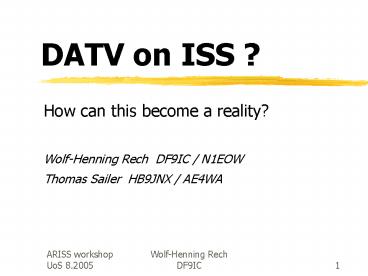DATV on ISS ? - PowerPoint PPT Presentation
1 / 15
Title:
DATV on ISS ?
Description:
Use open worldwide commercial broadcast standards - this ensures easy ... compare to 20 dB for 1200 Baud AFSK = 30...80 times better efficiency ... – PowerPoint PPT presentation
Number of Views:22
Avg rating:3.0/5.0
Title: DATV on ISS ?
1
DATV on ISS ?
- How can this become a reality?
- Wolf-Henning Rech DF9IC / N1EOW
- Thomas Sailer HB9JNX / AE4WA
2
D-ATV on ISS?
- Use open worldwide commercial broadcast standards
- this ensures easy availability of receiving
equipment - DVB / ETSI standards
- DVB-S (EN 300 431) since 1994
- DVB-S2 (EN 302 307) since 03/2005
- DVB-S FTA receiver costs 50-80 EUR (Germany,
2005)
3
D-ATV on ISS?
- Digital vs. analogue (FM) ATV
- scalable performance / bandwidth / RX sensitivity
- multiple video and audio streams available
- 10 - 20 dB better link performance
- PA needs better linearity / has less efficiency
- source encoder causes latency
- hard degradation in presence of strong
interference
4
D-ATV on ISS?
- Block diagramm of a DTV transmitter ...
- .... and a receiver
Video camera
A/D converter
Source Encoder
Channel Encoder
RF mo- dulator
Upcon- verter
Video monitor
D/A converter
Source Decoder
Channel Decoder
RF demo- dulator
Down- converter
Digital TV set-top box
5
D-ATV on ISS?
- Source Encoder
- removes redundant and irrelevant parts of the
signal - trade-off between data rate and signal
quality/latency - 1 ... 2 Mbit/s low quality - 4 ... 6 Mbit/s
high quality for SDTV
A/D converter
Source Encoder
Analog 5 MHz BW
Digital 80 - 200 Mbit/s
Digital 1 - 10 Mbit/s
6
D-ATV on ISS?
- Channel Encoder
- adds redundancy to the source coded signal for
error correction capability - R input data rate / output data rate 7/8 ...
1/4 - trade-off between required Eb/N0 at receiver and
bandwidth
Source Encoder
Channel Encoder
Digital 1.7 - 6 Mbit/s
Digital 120 Mbit/s
Digital 1.5 Mbit/s
7
D-ATV on ISS?
- Source encoding
- MPEG-2 (DVB-S and DVB-S2)
- MPEG-4 / H.264 (DVB-S2) for HDTV
- Channel encoding and modulation
- QPSK with R 1/2 FEC with convolutional
Reed-Solomon coding (DVB-S) - QPSK with R 1/2 - 1/4 FEC with BCH LDPC
coding (DVB-S2)
8
D-ATV on ISS?
Source ETSI TR 102 376
9
D-ATV on ISS?
- Required Eb/N0 incl. implementation loss
- 5 dB for DVB-S and 2 dB for DVB-S2
- compare to gt20 dB for 1200 Baud AFSKgt 30...80
times better efficiency - Receiver noise level (N0)
- T 290 K gt N0 -174 dBm/Hz
- Required signal power for 2 Mbit/s is -106 dBm
for DVB-S and -109 dBm for DVB-S2 - compare to -120 dBm for FM voice signal at
threshold and -115 dBm for 9600 Bd packet radio
10
D-ATV on ISS?
- Quick and dirty link analysis (1)
- assumed that the patch antenna at ISS is useable
up to -70 with 0 dBi gain (hopefully!) - then the minimum elevation at ground station is
10 and the maximum path length is around 1200 km
ISS
70
1200 km
300 km
10
Ground station
SSETI Express Patch Antenna
11
D-ATV on ISS?
- Quick and dirty link analysis (2)
- 1200 km _at_ 2.4 GHz mean 162 dB path loss
- TX EIRP assumed 40 dBm (10 dBW, 10 W at the
antenna feeding point with 0 dBi gain) - RX antenna assumed 1 m diameter dish with 40
efficiency, 10 angle at -3 dB and 24 dBi gain - results in a received signal power of(40 - 162
24) dBm -98 dBm - 8 dB margin at -106 dBm RX sensitivity
12
D-ATV on ISS?
- Amateur radio hardware for DVB-S
2.4 GHz
1.2 GHz
Power Amplifier (DB6NT)
DVB-S receiver
Main unit withbaseband processor
Video camera
MPEG Encoder
2400 MHz modulator
13
D-ATV on ISS?
- ... and what comes out of it
14
D-ATV on ISS?
- Summary
- Digital video over 1200 km LOS path is possible
with a 10 W EIRP transmitter and 24 dBi receiver
antenna gain - Low cost transmitter technology is available to
amateur radio and can be modified / adapted to
the special needs at ISS - Ground station is more complex that for FM voice
operation but within the capabilities of
technically skilled hams
15
D-ATV on ISS?
- When and how does it happen?































